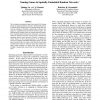116
click to vote
RSA
2011
14 years 7 months ago
2011
We study the cover time of random geometric graphs. Let I(d) = [0, 1]d denote the unit torus in d dimensions. Let D(x, r) denote the ball (disc) of radius r. Let Υd be the volume...
122
Voted
IM
2008
15 years 13 days ago
2008
Let G = G(n, r) be a random geometric graph resulting from placing n nodes uniformly at random in the unit square (disk) and connecting every two nodes if and only if their Euclide...
CORR
2006
Springer
15 years 14 days ago
2006
Springer
We investigate a prototypical agent-based model, the Naming Game, on random geometric networks. The Naming Game is a minimal model, employing local communications that captures th...
107
click to vote
CORR
2008
Springer
15 years 15 days ago
2008
Springer
A new random geometric graph model, the so-called secrecy graph, is introduced and studied. The graph represents a wireless network and includes only edges over which secure commun...
107
Voted
ALGORITHMICA
2007
15 years 17 days ago
2007
The unit ball random geometric graph G = Gd p(λ, n) has as its vertices n points distributed independently and uniformly in the unit ball in Rd, with two vertices adjacent if and ...
110
Voted
WCNC
2010
IEEE
15 years 4 months ago
2010
IEEE
—In this paper, we study node connectivity in multi-hop wireless networks. Nodal degree of connectivity as one of the fundamental graph properties is the basis for the study of n...
108
Voted
WOWMOM
2009
ACM
15 years 7 months ago
2009
ACM
Random Walks (RWs) have been considered for information dissemination in large scale, dynamic and unstructured environments, as they are scalable, robust to topology changes and d...
SODA
2010
ACM
15 years 9 months ago
2010
ACM
A Random Geometric Graph (RGG) in two dimensions is constructed by distributing n nodes independently and uniformly at random in [0, n ]2 and creating edges between every pair of...



